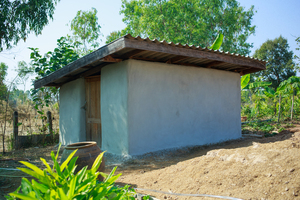This video is closing in on 1 million hits. Thanks to Leslie for this tip. Please send me your tips and suggestions for blog posts if you have some good ideas.
Emergency Shelter
Earthbag Training Center Proposal in Nepal
All of us were heartbroken over the recent earthquakes in Nepal. The big question now is what can I do to help in the most effective way? The following proposal is the rough draft of a Go Fund Me proposal to cover my expenses in Nepal for about two months starting in September. If you’re an NGO in Nepal who’s interested in setting up an earthbag training center, please contact me by email.
Emergency Shelter Option for Nepal

The photo shows the earthbag shelter design in our proposal to the UN. Earthbags are highly recommended since they’re tried and proven. However, in disaster areas bags and training may not be available, so it’s always good to have options. The emergency shelter idea explained here maximizes use of existing material and skills in Nepal in order to build shelter as quickly as possible.
News Report about Earthbag School Surviving Quake
We have already reported about the amazing survival of many earthbag structures in Nepal after their big quake. This fact is now being picked up by some major news outlets. For instance media conglomerate 3News in New Zealand has produced news accounts both on television and online:
“They say earthquakes don’t kill people, but buildings do – no more so than in Nepal where entire villages have been flattened. But in the rural village of Sangachok, there is one building that is still standing, all thanks to the handiwork of a team half a world away.
In Sangachok, there is destruction as far as the eye can see, but among the rubble and crumbled buildings there is some good news, and what could be a lesson for Nepal in earthquake resilience. Nelson-based First Steps Himalaya raised money to build the training centre for teachers to improve education in rural Nepal. The building remains standing even after the earthquake.
Volunteers from New Zealand and Nepal used rice bags filled with soil, which are laid out like bricks, covered with chicken wire and then plastered over. The Auckland company that helped construct it hopes it can deliver much more than that.
A Small Underground Dome Experiment
I own a few acres of desert property in Southern New Mexico and have often wondered what the underground temperature would be about 6 feet below the surface in this region. Summers can be quite hot and winters are fairly mild, so digging into the ground might be a good way to develop a residence that would be pleasant all year round, with very little additional energy input. To test this theory out, I thought that somehow burying a recording thermometer deep under ground would provide useful information.

Many people have asked about burying earthbag domes, and unfortunately I know of few actual examples of doing this. So I thought that a fun and informative experiment would be to build a small earthbag dome underground on our property, place the recording thermometer inside, and completely close it up for a year.
Huts on Ekopedia

“A hut is a temporary shelter built with materials found nearby. It is generally built manually in a natural environment with local materials : branches, leaves, logs, bushes, etc. … Less commonly, it can also be made of materials such as metal (iron), cloth or plastic (sheeting), and be located in an unnatural area such as a backyard or on the water (stilts).
